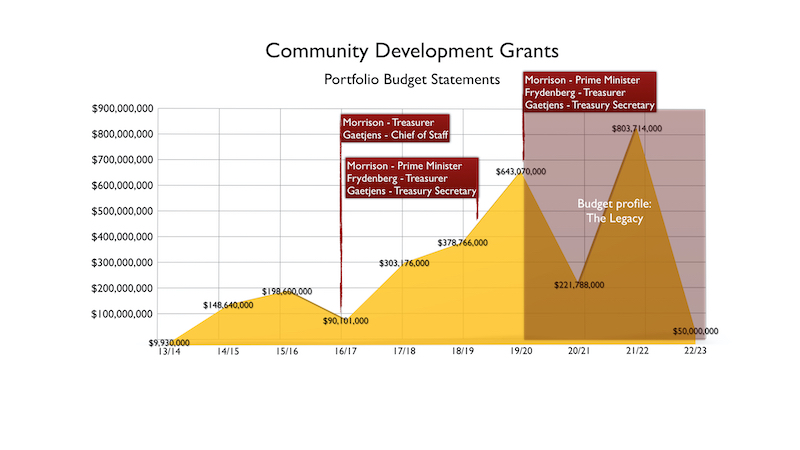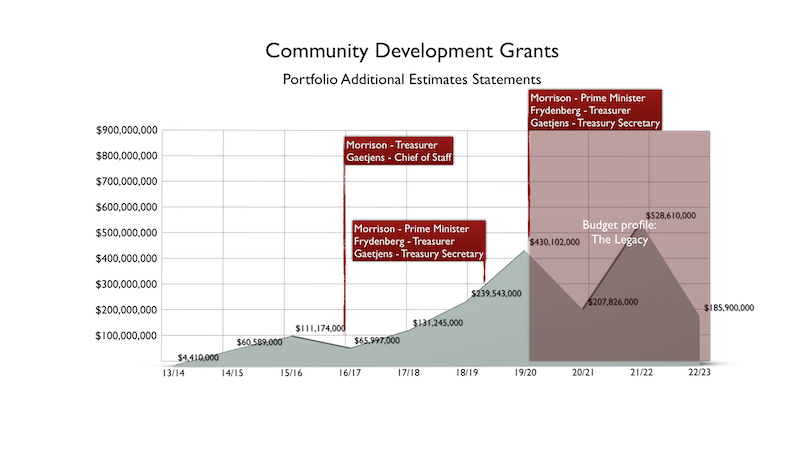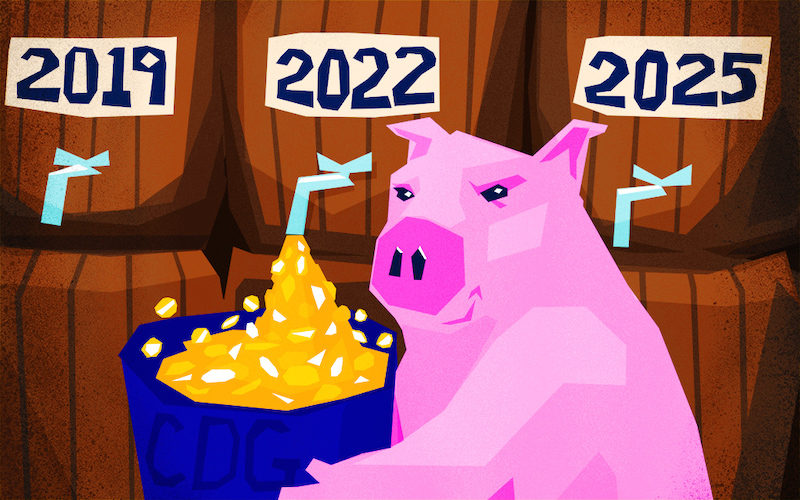The Government has teed up a “community chest” of future rorts to target marginal seats in two more elections. The blatant manipulation of voters does not end with #sportsrorts and other assorted grants rorts. Jommy Tee has uncovered a cunning plan which could see Community Development Grants pork-barrel another two election campaigns.
In late October 2019, a notice of a grant opportunity appeared on the government’s GrantConnect website — the website where all federal government grants and opportunities are published.
Although the notice is small and undoubtedly slipped under the radar, the potential for a serial plunder of taxpayers’ dollars is huge.
The notice advises that the Community Development Grants (CDG) program had been extended to 30 June 2026. As readers know, we previously exposed the CDG as yet another of the government’s slush funds. We showed how it was regularly topped up, especially between 2016 and 2019 when the combination of Scott Morrison and his then chief of staff (and later Treasury secretary), Phil Gaetjens, controlled the budget levers.
Community Development Grants from Jommy Tee on Vimeo.
The official extension of the CDG provides the government with yet another campaign war chest of $1 billion for the next election in 2022 and a yet-to-be-determined figure for the election after that in 2025 — a case of rolling rorts. Why stop at one election when you can buy three?
Any hope that the blatant manipulation of grant funding ended with the #sportsrorts is wishful thinking. The slush pipelines have been cleared and are now ready to deliver goodies to marginal seats in the next two elections.
The $1 billion community chest of future slush can be found in the government’s own budget documentation, in particular the portfolio budget statements (PBS) and portfolio additional estimates statements (PAES) of the infrastructure department. The CDG is administered by the infrastructure department.
Firstly, a brief and crude explanation of the difference between the PBS and the PAES to understand the difference between projected and “actual” budget expenditure. No need to fear, we’ll use an everyday example.
Say it’s the beginning of the year and the family are planning a holiday. How about Hawaii and a budget of $15,000 all up? That effectively is the PBS — a projected expenditure for the year ahead. Let’s now say we’re near the end of the year and we’ve had the holiday but had to cut it short. Hence, we saved some money with the bill totalling $12,000. That’s the PAES – a later but more accurate assessment of that year’s finances – usually delivered around the third quarter of the financial year.
Back to checking the slush pipeline. The last budget just weeks out from the election was delivered by Josh Frydenberg with Phil Gaetjens as head of Treasury at the time. This was the famous “back in black” budget — a tad premature with its bold pronouncement.
The legacy of that budget (which also includes projections for future years) was a big-spending campaign war chest of $1.08 billion ready for the next election, deliverable over the period 20/21 to 22/23.
At this stage, we can’t look beyond that as no official figures have been released. Future budgets will contain some of those figures.
So in short, at this stage, at least a $1 billion is in the kitty ahead of the next election in 2021-2. It would be surprising if that figure wasn’t bolstered to enable the government to buy the 2025-6 election.
As revealed on the following graph (source: Dept of Infrastructure various PBS), the 2019 pre-election budget
- earmarked $643 million for the CDG in 19/20 (which potentially bought a lot of marginal seat votes and 2019 election promises),
- foreshadowed $222 million in 20/21,
- revealed a whopping $803 million in 21/22 (possible election year) and
- a further $50 million in 22/23.

At the time of the budget, the CDG was meant to cease at 30 June 2020. Archived program guidelines clearly state:
“Funding will commence in the 2013-14 financial year and will cease on 30 June 2020. Multi-year projects must be scheduled for completion and final payment made on or before 30 June 2020.”
Yet, the budget projections clearly show the funding extended well beyond 2020. In fact, the budget papers show funding going out to 22/23. Provided the government was returned in 2019, getting an extension was a fait accompli, so much of a fait accompli that the coffers beyond the 2020 would be awash with slush.
To be fair to the government, we also analysed the PAES documentation for the CDG. The results indicate spending has been marginally reined in with only $430 million likely to be spent this financial year, $208 million in 20/21, a still extravagant $529 million in 21/22, and $186 million in 22/23 (see graph below; source: Dept of Infrastructure various PAES):

According to the PAES, the total for the out-years (20/21 to 22/23) is $923 million compared to the $1.08 billion projected in the last budget … but let’s not quibble, viewed from any angle, it remains an overly-bloated indictment.
What the two graphs also show that a very clear pattern has emerged.
There are three distinct humps within the graph, corresponding to election cycles. Again, this is no surprise as the CDG’s only purpose is to gratuitously fund election commitments, more sporting infrastructure and community facilities for the invited few and more glib marketing for the rest of us.
What is disturbing is the ever-increasing size of each hump. Is it a mere coincidence that the major funding spikes have occurred after Scott Morrison’s successful tilt at PM?
Of course, part of the funding will pay for some existing projects which run across multiple years, providing multiple media opportunities for the lucky local member/candidate. However, much of the funding will go to projects that have not yet been “invited” to apply for CDG funding.
Perhaps as a gesture of good faith, the various sporting organisations who were discriminated against based on “colour” rather than the merit, could be invited to lodge a CDG application? Such a move might ward off the legal action the government faces from applicants that unfairly missed out.
In fact, there is probably enough fat in the funding projections for the government to draw down on the CDG funding chest for more pressing challenges such as addressing current environmental and resilience issues. However in announcing his response to the COVID-19 and economic crises, Morrison wrote to Liberal Party subscribers about the government’s stimulus package advising them
“importantly, we are not baking spending into the Budget bottom line for years to come”.
As the extension of the CDG to 2026 shows, that seems to be a privilege only reserved for an election slush fund. Unlike the notional $2 billion bush fire recovery fund, the CDG is alive and kicking — and well-funded.
The community chest that is the CDG is much like the one in the board game, Monopoly. It contains many riches, but unlike the Monopoly version, has no “Go to Jail” cards in its deck.
——————-
History repeating – Community Development Grants from Jommy Tee on Vimeo.
Jommy Tee is a long-time career public servant, having worked in the policy development field for 25+ years as well as an independent researcher interested in politics, current affairs, and Nordic noir.

